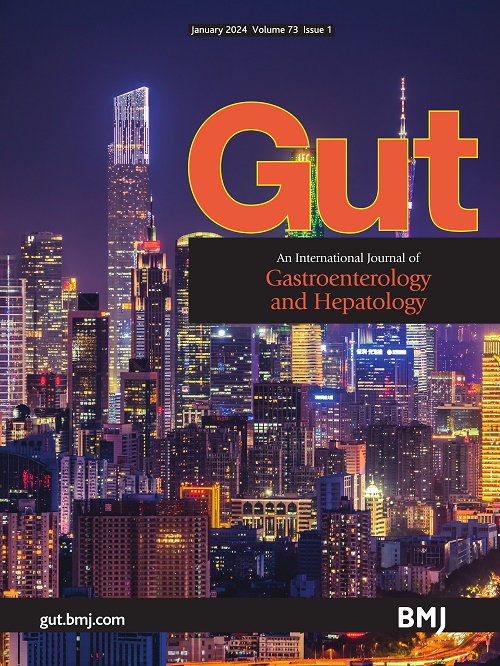胆囊切除术史患者的全球患病率和胃肠道症状负担
IF 25.8
1区 医学
Q1 GASTROENTEROLOGY & HEPATOLOGY
引用次数: 0
摘要
背景胆囊切除术在全球范围内都很常见,许多肠脑相互作用障碍(DGBI)患者报告称,他们的症状在胆囊切除术之前或之后出现。目的确定自我报告胆囊切除术史的全球患病率,并探讨其与DGBI罗马IV诊断标准的关系。首先,我们使用来自罗马基金会全球流行病学研究的基于人群的互联网问卷数据(n=54 127)来计算自我报告胆囊切除术史的横断面患病率。其次,我们比较了胆囊切除术后符合DGBI诊断标准的患病率,使用逻辑回归模型计算潜在混杂因素调整前后的or (AOR)。结果:我们确定了2709例胆囊切除术患者,全球患病率为5.0% (95% CI 4.8 - 5.2)。全球差异遵循东西梯度,从亚洲的1.9%到北美的9.9%不等。胆囊切除术与满足任何DGBI症状标准的发生率较高相关(AOR为1.50,胆囊切除术组为56.2%,未胆囊切除术组为42.3%),其中胃十二指肠的AOR最高(AOR为1.73;19.9% vs 11.8%)和肛肠(AOR 1.71;17.0% vs 8.4%),其次是食道疾病(AOR 1.47;12.3% vs 6.6%)和肠(AOR 1.38;47.5% vs 35.4%)。结论胆囊切除术在世界范围内普遍存在,但各地区存在差异。该手术的病史与较高的胃肠道症状负担相关,可能是由于新的胆囊切除术相关症状,或者是由于错误地进行了胆囊切除术的胆道疾病而导致的持续性DGBI。所有与研究相关的数据都包含在文章中或作为补充信息上传。在线补充包含了本研究中使用的所有汇总患者数据的广泛摘要。有关研究数据库(罗马基金会全球流行病学研究)的更多信息,请参阅罗马基金会的网站:。在提交的项目提案获得批准后,可根据罗马基金会全球流行病学研究组概述的程序访问该数据集。本文章由计算机程序翻译,如有差异,请以英文原文为准。
Global prevalence and gastrointestinal symptom burden of individuals with a history of cholecystectomy
Background Cholecystectomy is commonly performed globally, and many patients with disorders of gut-brain interaction (DGBI) report that their symptoms have either preceded or developed following cholecystectomy. Objective To determine the global prevalence of a self-reported history of a cholecystectomy and investigate its association with fulfilling Rome IV diagnostic criteria for DGBI. Design First, we used population-based internet questionnaire data from the Rome Foundation Global Epidemiology Study (n=54 127) to calculate the cross-sectional prevalence of a self-reported history of cholecystectomy. Second, we compared the prevalence of meeting diagnostic criteria for DGBI by cholecystectomy, using logistic regression models to calculate ORs before and after adjusting (AOR) for potential confounders. Results We identified 2709 subjects with cholecystectomy, corresponding to a global prevalence of 5.0% (95% CI 4.8 to 5.2). Global differences followed an east to west gradient, ranging from 1.9% in Asia to 9.9% in North America. Cholecystectomy was associated with a higher prevalence of fulfilling symptom criteria for any DGBI (AOR 1.50, 56.2% with cholecystectomy vs 42.3% without cholecystectomy), with the highest AOR found for gastroduodenal (AOR 1.73; 19.9% vs 11.8%) and anorectal (AOR 1.71; 17.0% vs 8.4%) disorders, followed by oesophageal (AOR 1.47; 12.3% vs 6.6%) and bowel (AOR 1.38; 47.5% vs 35.4%) disorders. Conclusion Cholecystectomy is prevalent worldwide and varies across world regions. A history of this procedure is associated with a higher GI symptom burden, either due to new cholecystectomy-related symptomatic conditions, or persistent DGBI misattributed to biliary disease for which a cholecystectomy was erroneously performed. All data relevant to the study are included in the article or uploaded as supplementary information. The online supplement contains an extensive summary of all aggregated patient data used for the present study. For more information about the study database (Rome Foundation Global Epidemiology Study), we refer to the website of the Rome Foundation:
求助全文
通过发布文献求助,成功后即可免费获取论文全文。
去求助
来源期刊

Gut
医学-胃肠肝病学
CiteScore
45.70
自引率
2.40%
发文量
284
审稿时长
1.5 months
期刊介绍:
Gut is a renowned international journal specializing in gastroenterology and hepatology, known for its high-quality clinical research covering the alimentary tract, liver, biliary tree, and pancreas. It offers authoritative and current coverage across all aspects of gastroenterology and hepatology, featuring articles on emerging disease mechanisms and innovative diagnostic and therapeutic approaches authored by leading experts.
As the flagship journal of BMJ's gastroenterology portfolio, Gut is accompanied by two companion journals: Frontline Gastroenterology, focusing on education and practice-oriented papers, and BMJ Open Gastroenterology for open access original research.
 求助内容:
求助内容: 应助结果提醒方式:
应助结果提醒方式:


